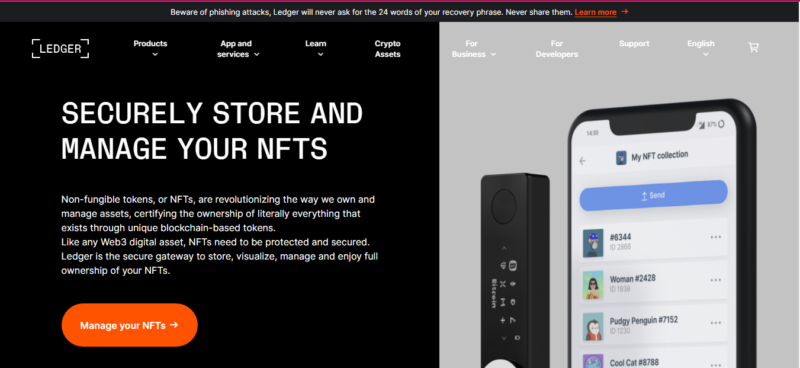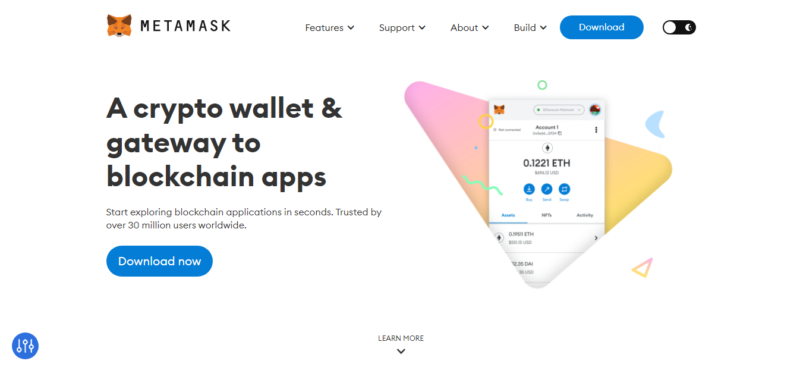How to Secure NFT Assets: A Complete Guide for 2025
Purchasing NFTs is only the first step. You need to learn how to keep such digital assets away from prying eyes. Read on to discover how to secure NFT assets and learn about the various NFT storage options and their use cases.
If there’s any term that can describe the current NFT market, it’s the Wild West. Because the NFT space is still experimental and regulations are unclear or lax, it has attracted a flood of hackers and scammers who are on the hunt for a payday. If you own digital assets or you’re looking to dip your toes into the market, you need to learn how to secure NFT assets.
Scammers’ favorite way to steal your NFTs is through phishing scams. Once they enter your account, they’ll drain it. Others bait users to invest in fraudulent or nonexistent NFT schemes, only to disappear once investments pour in.
Follow along as we dig deep into proven ways to store your NFTs in a way that shuts out all kinds of swindlers. Let’s start by understanding what NFTs are and what a blockchain does.
-
10/01/2024
We verified the steps and updated the ranking to reflect current VPN performance, features and pricing.
-
02/05/2025 Facts checked
Added more information about the best VPNs for securing NFTs.
How to Secure NFT Assets: Know the Basics
Before we dive into our tips on how to keep NFTs secure, we need to make sure you understand what NFTs are, how blockchain works, and how NFTs can be stolen in the first place.
Protect Your Privacy. Get Our Free VPN Guide Now!

- Comprehend the essential role a VPN plays in safeguarding your digital life
- Gain a deep understanding of how VPNs function under the hood
- Develop the ability to distinguish fact from fiction in VPN promotions
What Are Non-Fungible Tokens (NFTs)?
Short for non-fungible tokens, NFTs are unique digital assets that exist on a blockchain and serve as proof of ownership. Items that have been sold as NFTs include paintings, images, videos, in-game items and even tweets.
To better understand NFTs, you need to grasp the keyword “non-fungible.” Take a dollar bill, for instance. Any dollar bill can be swapped with another, making it a fungible — or interchangeable — asset. However, there’s no way you can replace a Beeple artwork, for example, with any other image.
NFT records are kept on a blockchain to ensure trades are verifiable. Most NFTs are part of the Ethereum blockchain, although other blockchains like Solana, Tezos and Binance Smart Chain also support NFTs.
What Is Blockchain and How Does It Work?
A blockchain is a digitally distributed and open ledger that enables transactions between various parties in a secure manner.
Because a blockchain is public to everyone across specific networks, it’s immutable. No one can hack the ledger and change or edit any transaction details unless they own over 50% of all nodes. That’s why blockchains have been the backbone of cryptocurrency transactions.
A typical blockchain works by a multistep process. First, an authorized person on the system initiates a transaction. The blockchain verifies the transaction and creates a “block” that represents the transaction.
Next, all the computer nodes in the network double-check the transaction and add it to the blockchain. The update is then distributed across the blockchain as a verifiable record. If you’re curious about learning more about the blockchain, our bitcoin guide has a useful description of how it works in detail, and it’s lean on jargon.
As mentioned earlier, the most popular blockchain for NFTs is Ethereum. It comprises some of the best NFT marketplaces, projects and artists. However, it’s quite pricey and consumes lots of energy. There are cheaper blockchain options like Solana, Tezos and Flow, but they may not have access to the broad suite of projects and marketplaces that Ethereum offers.
Can NFTs Be Stolen?
Your NFTs can be stolen if you don’t take the necessary security steps. In most cases, hackers use phishing attacks to get access to your NFT wallet. For example, if you click on a disguised malicious link and enter your login details, a hacker can access your login information and steal your prized assets.
Another way hackers and scammers steal NFTs is through deceptive NFT projects. These fraudulent characters often set up an NFT project and hype it across various social media platforms. Once investors take the bait, the scammers shut up shop and disappear with the funds — a practice known as a rug-pull scam.
Other popular NFT scams include bidding scams, pump-and-dump schemes and plagiarized NFTs. If you want to dig deep into these scams (and other less popular ones), read our post on the most common NFT scams.
Store Your NFTs Securely: Common Methods
There are a variety of NFT wallets and crypto wallets that allow you to store and transfer your NFTs safely. Below, we explore the three main ways to keep your NFTs away from malicious actors.
Cold Storage Hardware Wallet

A cold storage hardware wallet is a physical device, like a USB stick, that allows you to store your NFTs offline. Unless a hacker or scammer has that physical device, they can’t access your digital assets or private keys. That’s why hardware wallets are the safest way to store NFTs.
If you intend to hold on to your NFT for an extended period or you have a collection of high-value NFTs that scammers might be drooling over, then a cold storage wallet is a great choice.
Popular hardware wallets include Ledger and Trezor. It’s important that you avoid purchasing a hardware wallet from third-party resellers or that has been pre-owned; you could be buying a wallet that has already been compromised.
Software Wallets

If you constantly buy and sell NFTs, then you might need a software wallet. In fact, some marketplaces require such wallets to make transactions faster and easier. Also known as hot wallets, software wallets are generally available as mobile apps, browser extensions and desktop applications.
There are plenty of software wallets available, but the most popular is MetaMask, which protects your transactions with a password and a seed phrase. Other useful software wallets include Trust Wallet, Rainbow, Enjin Wallet and Math Wallet.
Although software wallets are more convenient, they are more vulnerable to attacks since your private keys travel online.
InterPlanetary Files System (IPFS)

The InterPlanetary Files System (IPFS) is a decentralized protocol that stores your NFTs off-chain, making it hard for hackers to access your NFTs. IPFS utilizes a content-based addressing system instead of the usual location-based address system.
This means that each time you add content to the IPFS, it’s given a unique content identifier (CID), which is less susceptible to hacking than standard URLs. The CID hashes are stored on your computer and you’ll be alerted if ever an attempt is made by a hacker node. If you’re interested in using an IPFS, check out Pinata, one of the fastest-growing IPFSs.
Secure Your NFTs: Safety Tips
Regardless of the NFT storage system you’re using to keep your NFTs safe, you need to follow some best practices to ensure that your NFT assets are protected at all times:
- Use a virtual private network (VPN) to encrypt and anonymize your traffic. We recommend NordVPN, the best VPN on the market. Read our article on the best NFT VPNs to get started.
- Avoid clicking suspicious and dodgy links. You might end up on a malware-ridden or phishing site.
- Never share your seed phrase or login credentials with anyone or on any site.
- Do your own research before investing in an NFT project. Check the profile and background of project founders before investing.
- Only trade on reputable NFT marketplaces and use a safe digital wallet.
- Use two-factor authentication to add an extra layer of security to your crypto wallet.
The Best VPNs to Secure Your NFT Assets
We researched and tested the ability of dozens of VPNs to protect NFT assets. Below, we walk through the ones that came out on top. Let’s kick-start things with our top pick, NordVPN. Better still, you can read our detailed best NFT VPN article.
1. NordVPN — Best VPN Overall


Very Fast

Very Fast

Very Fast
NordVPN is the best VPN to secure your NFT assets. It may have more affordable plans than some other premium VPNs but offers advanced security features. For example, the double VPN feature makes it twice as hard for snoopers to access your traffic and the threat protection screens and alerts you about malicious sites.
Learn more about this useful VPN service in our full NordVPN review.
2. Surfshark — Best Budget VPN for Protecting NFT


Very Fast

Very Fast

Very Fast
Surfshark only narrowly misses out on the top VPN spot. Don’t let Surfshark’s cheap long-term pricing fool you: It’s a powerhouse VPN provider with an extensive library of security features. For this reason, we’re happy to recommend Surfshark for helping to secure your NFT assets.
If you’d like to dig deeper into Surfshark’s performance, pricing and features, we have a full Surfshark review.
3. ExpressVPN — Best User-Friendly VPN for Securing NFT Assets


Very Fast

Very Fast

Very Fast
ExpressVPN’s excellent obfuscated and RAM-only servers do an excellent job of hiding your traffic and protecting your privacy. Even if your internet connection accidentally drops, you can bank on ExpressVPN’s kill switch and leak protection to hide your details.
On top of that, this VPN service has blazing-fast speeds perfect for minting and uploading NFTs. Explore this VPN in our ExpressVPN Review.
Final Thoughts
A crypto wallet is a must-have if you want to secure your prized digital assets. If you trade often, then a software wallet is your best bet. However, for the best security and to store NFTs for the long haul, use a hardware wallet.
If you need to consider a VPN, we recommend NordVPN. Curious about NordVPN? Its 30-day refund policy means you can explore all its features worry-free and decide if it’s the right fit for you. For an excellent alternative, try Surfshark.
Which NFT wallet storage option is your favorite? Have you ever had NFTs stolen? What’s your main takeaway from this article? Share your thoughts with us in the comments section below, and as always thanks for reading.
FAQ
Fraudulent persons can steal your NFTs using all kinds of strategies from phishing scams to pump-and-dump schemes. For the best security, store your NFTs offline in a cold storage hardware wallet.
Use a VPN to encrypt and anonymize your traffic. Be sure to always update your antivirus and never click on dodgy links. Better yet, store your NFTs offline in cold storage to protect them from scammers and hackers.


